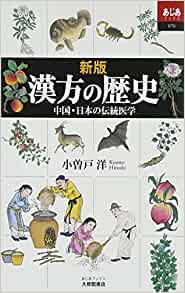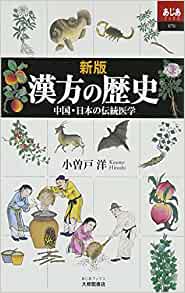小曽戸博 著「新版 漢方の歴史」 あじあブックス
日本で学ぶ留学生向けの地域学習講座で、日本の医療史を説明する際、参考にした本の一つが、この新版 漢方の歴史です。説明用のパワーポイントを作るために資料を読み込んでいると、日本の医療の歴史と漢方は切っても切り離せないところがあり、一度、通史として確認しておこうと思いました。
外国医師渡来の歴史は古く、「大和朝廷は百済・新羅・高句麗に対して積極的な姿勢で医薬知識の供与を求めていた」そうです。一番古い記録は、「允恭天皇3年(446年?)朝廷は新羅に遣使して良医を求め、金武(こんむ)が来朝して天皇の病を治療した」といいます。
大分、時代は下りますが、12世紀後半に日宋貿易が盛んになり、印刷された書籍が輸入されました。留学僧などが帰国の際に、宋版の医学書を持ち帰っています。
鎌倉時代初期では、臨済宗を広めた栄西が、入宋経験による学識をもとに著書『喫茶養生記』(1211)を著しました。新しい薬としての茶と桑の効用を説いています。日本人の僧・梶原性全は宋の医学文献から学び、日本中世最大の医学全書『頓医抄』『万安方』を編纂しています。単なる翻訳ではなく、中国の最新医学を日本人なりに解釈しなおした書物です。
中国が明王朝の時代、日本はきわめて旺盛に明の医学文化を吸収しましたが、次の清王朝の時代に入ると、清の医学書の影響は薄れていき、日本の医学は独自の進化を歩むことになりました。日本の室町末期から安土桃山時代に活躍した、曲直瀬道三(1507~94)は中国医学を日本に導入し、根づかせました。足利義輝・毛利元就・織田信長・豊臣秀吉・稲葉一徹等の将軍、武将の医療を担当しました。
ただ、日本では西洋医学が次第に勢力を増してきました。その後、衰退と復興した漢方の歴史は、本書にてご確認ください。(完)

漢方の歴史新版 中国・日本の伝統医学 (あじあブックス) [ 小曽戸洋 ]
価格:1,870円
(2021/5/23 21:44時点)
感想(1件)
“History of Kampo, New Edition” by Hiroshi Kosoto, Ajia Books
One of the books I used as a reference when explaining the history of Japanese medicine in a local study course for international students studying in Japan was this new edition of the History of Kampo. As I was reading through the materials to make a PowerPoint presentation, I realized that the history of Japanese medicine and Kampo are inseparable, and I wanted to check it out as a general history.
The history of the arrival of foreign doctors is old, and it is said that “the Yamato Imperial Court took a proactive stance toward Baekje, Silla, and Koguryo, asking those nations to provide Japan
with medical knowledge. The earliest record is from the 3rd year of Emperor Ingyou (446?), the court sent an envoy to Silla to seek a good doctor, and Konmu came to Japan and treated Japanese emperor’s illness.
In the latter half of the 12th century, the Japan-Sung trade flourished, and printed books were imported. When study-abroad monks returned to Japan, they brought back medical books printed in the Song dynasty.
In the early Kamakura period (1185-1333), Eisai, who spread the Rinzai sect of Buddhism, wrote a book entitled “Tea and Health” (1211) based on his learning from his experience in the Sung. The book explains the benefits of tea and mulberry as a new medicine. The Japanese monk Kajiwara Shozen learned from the medical literature of the Sung dynasty and compiled the largest medical treatises of the medieval period in Japan, “Ton I Sho” and “Man An Ho”. These books were not mere translations, but reinterpretations of the latest Chinese medicine in the Japanese way.
During the Ming dynasty in China, Japan absorbed Ming medical culture with great vigor, but as the Qing dynasty came in, the influence of Qing medical books faded and Japanese medicine evolved on its own. Manase Dozan (1507-94), who was active in Japan from the late Muromachi period to the Azuchi-Momoyama period, introduced Chinese medicine to Japan and made it take root. He was in charge of medical care for shoguns and military commanders such as Ashikaga Yoshiteru, Mori Motonari, Oda Nobunaga, Toyotomi Hideyoshi, and Inaba Ittetsu.
However, Western medicine gradually gained power in Japan. The history of Kampo, with its subsequent decline and revival, can be found in this book. (End)
“Histoire du Kampo, nouvelle édition” par Hiroshi Kosoto, Ajia Books
L’un des livres que j’ai utilisés comme référence pour expliquer l’histoire de la médecine japonaise dans le cadre d’un cours d’étude local destiné aux étudiants internationaux étudiant au Japon était cette nouvelle édition de l’Histoire du Kampo. Alors que je lisais les documents pour faire une présentation PowerPoint, j’ai réalisé que l’histoire de la médecine japonaise et du Kampo étaient inséparables, et j’ai voulu le consulter comme une histoire générale.
L’histoire de l’arrivée de médecins étrangers est ancienne, et on dit que “la Cour impériale de Yamato a adopté une attitude proactive envers Baekje, Silla et Koguryo, demandant à ces nations de fournir au Japon
des connaissances médicales. La plus ancienne trace remonte à la 3ème année de l’empereur Ingyou (446 ?), la cour a envoyé un émissaire à Silla pour chercher un bon médecin, et Konmu est venu au Japon et a traité la maladie de l’empereur.
Dans la seconde moitié du XIIe siècle, le commerce entre le Japon et les Song était florissant, et des livres imprimés étaient importés. Lorsque les moines partis étudier à l’étranger retournaient au Japon, ils ramenaient des livres de médecine imprimés sous la dynastie Song.
Au début de la période Kamakura (1185-1333), Eisai, qui a répandu la secte Rinzai du bouddhisme, a écrit un livre intitulé “Thé et santé” (1211) basé sur les enseignements tirés de son expérience chez les Sung. Le livre explique les bienfaits du thé et du mûrier en tant que nouvelle médecine. Le moine japonais Kajiwara Shozen s’est inspiré de la littérature médicale de la dynastie Sung et a compilé les plus grands traités médicaux de la période médiévale au Japon, “Ton I Sho” et “Man An Ho”. Ces ouvrages n’étaient pas de simples traductions, mais des réinterprétations de la dernière médecine chinoise à la manière japonaise.
Pendant la dynastie Ming en Chine, le Japon a absorbé la culture médicale Ming avec beaucoup de vigueur, mais avec l’arrivée de la dynastie Qing, l’influence des livres médicaux Qing s’est estompée et la médecine japonaise a évolué par elle-même. Manase Dozan (1507-94), qui a été actif au Japon de la fin de la période Muromachi à la période Azuchi-Momoyama, a introduit la médecine chinoise au Japon et l’a fait prendre racine. Il était chargé des soins médicaux pour les shoguns et les commandants militaires tels que Ashikaga Yoshiteru, Mori Motonari, Oda Nobunaga, Toyotomi Hideyoshi et Inaba Ittetsu.
Cependant, la médecine occidentale a progressivement pris le pouvoir au Japon. L’histoire du Kampo, avec son déclin et son renouveau ultérieurs, se trouve dans ce livre. (Fin)
